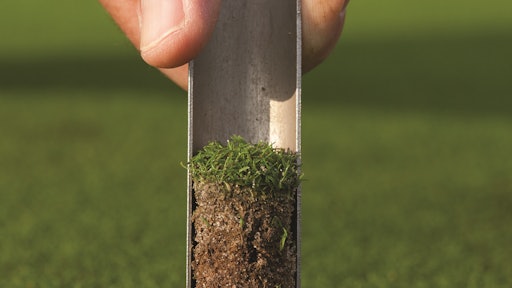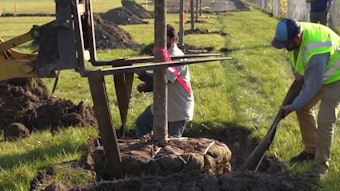
The Village of Grayslake, IL, located roughly 40 miles north and slightly west of Chicago, recently passed a law banning the use of phosphorus-based fertilizers in lawn care. One of the few exceptions is when a soil test confirms that a given lawn is deficient in phosphorus. You see, much like when a medical doctor does a biopsy or takes a throat culture, a soil test will scientifically and definitively tell you what is going on with a lawn—along with what needs to be done to nurse it back to health.
For years and years, true lawn care professionals have been frustrated by "inferior competitors", "lowballers" or whatever you want to call them. The true professionals would like to see more respect given to the lawn care profession. The best way to do that is to draw attention to the complexity of sustainable lawn care, along with the knowledge base, skillset and level of training required to effectively deliver lawn care services.
Why, then, do so few lawn care professionals make soil testing a core element of their lawn care offering?
"From what I see, lawn care contractors who religiously do soil testing represent less than 1% of the contractors in business today," says Barry Draycott, a 36-year veteran of the green industry. "The general recommendation is to sample and test a lawn every three years. If we could get that 99% to start testing every three years, it would be fantastic."
According to Draycott, there are a few main reasons why so few contractors currently do soil testing on a proactive basis. First of all, it takes extra time and costs money; not much money, but it does cost money. Second, many consumers simply want a green lawn, irrespective of how you go about delivering one. Thirdly, you can make a lawn green by indiscriminately applying nitrogen, and you can rid it of most weeds and pests by blasting it with pesticides. Not all consumers want that, but many still don't seem to care.
So what's the message a lawn care professional should be trumpeting? "By doing a soil test, you're studying more than just soil nutrients and pH," Draycott says. "The results of a soil test will tell you how you can reduce costly inputs like water, fertilizer and pesticides, and also provide insights as to how you can prevent runoff. Yes, you can make a lawn green by applying nitrogen. But too much nitrogen can also weaken the turf, leading to more disease and insect problems. And if you're not doing things that lead to deeper root growth, the lawn will have more problems with heat and drought. It's really about doing what is best for that lawn over a period of time, and a soil test is the best way to determine what the best way forward is."
Contractors plant the seed, reap the benefits
For the few contractors who are religiously doing soil tests, they are reaping the benefits of what they sow. Zack Kline is one example. He's the owner of A.I.R., an eco-friendly land management company that stands for atmosphere-improvement-renewal. The company is based in Rockville, MD. Kline says soil testing is a great service to offer because it allows you, the contractor, to provide a report card of sorts. "You can provide a report on soil metrics and then offer the customer tips on what they can do to get their metrics, or report card grade, higher," Kline says.
Another contractor who religiously does soil testing is Dean Reda of Green Escape Property Maintenance in Huntley, IL. Huntley is located about 30 miles southwest of Grayslake where the most recent phosphorus ban was put in place back in March. "We include a basic soil analysis for free as a regular part of our service," Reda points out.
Reda tells customers that a soil test should always be conducted in the following scenarios:
- Before establishing a new lawn from seed or sod
- Annually when attempting to correct a nutrient deficiency or to change soil pH
- When fertilizers containing phosphate or potash have been used on a regular basis for a number of years
- Every three years on established lawns to prevent problems.
Soil testing tips
Draycott points out that it's important to take your soil samples at the same time of year. "You could get very different results if one year you took the sample in May and the next sample is taken three years later in September," Draycott cites as an example.
It's also important to take numerous samples from different areas of the lawn. As detailed by the University of Minnesota Extension, it's advisable to take 5-10 samples from smaller lawns not exceeding 1,000 square feet. For large lawns such as athletic fields or industrial grounds, you probably want to take 10-15 samples.
"You want to get down to 3-6 inches deep for each sample," Draycott adds. Using a soil tube/probe is your best method, though a garden trowel or spade would also work. "Then take all of the samples and mix them together in a clean pail. Most soil labs will give you instructions on how they want them prepared, packaged and presented; it’s not complicated."
Next comes the analysis. Many contractors take their samples to a university extension office. “What I see, though, is that contractors will tend to favor a private lab because they can typically get the results a lot faster," Draycott relates. "You do have to recognize that different labs use different techniques to analyze. They use different types of acids to draw out what nutrients are missing in the soil sample. So once you find a lab you like, you don’t want to be switching. You want to keep things as consistent as possible."
So you get this report back from the lab. Now what? All the client is really concerned about is having nice green turf. But if the applicator doesn’t know, for example, if the pH is way out of whack and the plants won’t be able to absorb a lot of the nutrients he’s putting down, the program will not be successful. So the soil test tells that contractor how to get the best results on that property, and that’s what the contractor needs to be explaining to the client.
Reda says he's looking for the following information in a soil analysis:
pH. Measures the acidity or alkalinity of the soil. Indicates whether a lawn needs soil additions such as lime to bring the soil pH within reasonable levels to allow for optimum nutrient uptake.
Macro-nutrients. Phosphorus, potassium and nitrogen are necessity components for healthy and hardy turf growth. Draycott notes that soil testing for nitrogen has limited value because nitrogen is very volatile and its level changes on a very frequent basis.
Micro-nutrients. Iron, calcium, zinc, boron, manganese, magnesium, copper, etc. are all required in the soil to deter weeds, disease and pests, and to promote a healthy, dense lawn. Draycott says the calcium:magnesium ratio is quite important. A 7:1 ratio is ideal because it will allow for much better nutrient absorption.
Soil type. Knowing whether your soil is sandy, loam or composed of clay will help you indicate potential problems with compaction or drainage.
"Cation exchange capacity, noted as CEC, is another important thing to look for," Draycott adds. "CEC shows the soil's ability to hang onto cations, which are potassium, calcium and magnesium. The higher the number, the better."
Organic matter. Decomposed plant materials add organic matter to soil and is required for healthy soil structure and water retention. This is where it can get a little bit tricky—especially with respect to organic-based lawn care.
"It’s a little bit different with organic lawn care because we rely so much on the health of the soil, and that goes beyond just adding nutrients and adjusting the pH," Draycott says. "In fact, there’s an additional test you can do beyond the typical soil test. This test is a biological assay, basically, which tests for different types of bacteria and fungi, etc. If you’re dealing in organics, it’s highly advisable to do this bioassay. It can be pretty expensive, which is why some might shy away from it. But it is important information, because understanding what is happening with the soil is critical in organic lawn care."
There aren't too many labs that do bioassays on soil samples, Draycott points out, which presents yet another challenge. As a general rule, bioassays are not utilized for residential accounts. Rather, if you had a large property where the desire to be truly organic is important, the bioassay would be an important step, according to Draycott.
In most instances, a run-of-the-mill soil test would do. More lawn care professionals doing them would be a very positive step for the profession.
"When you consider the typical person's desire to be more environmentally sound—along with their desire to reduce pesticide use and resistance build-up in their lawn—soil tests are an obvious first step," Draycott reminds. "It's an obvious and important first step that lawn care professionals should not be skipping."
Barry Draycott is the owner of Tech Terra Environmental, a New Jersey-based company specializing in Integrated Nutrient Management (INM) and Minimum Risk Pesticides for turf and ornamentals. Draycott has been in the green industry since 1980. His passion has been to help the landscape industry understand how to successfully and profitably maintain landscapes while reducing the need to apply so many pesticides. Visit techterraenvironmental.com for more information.





























